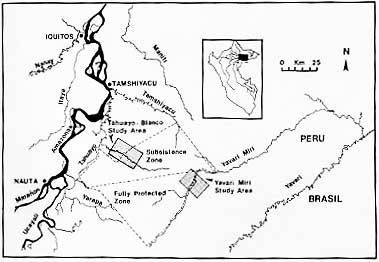

Study area
Two study areas were researched between June 1990 and August 1992 in the Reserva Comunal Tamshiyacu-Tahuayo situated in northeastern Peru between the Tamshiyacu, Tahuayo and Yavari Miri rivers (Fig. 1). The reserve covers an area of 322 500 ha of continuous forest and is predominantly (> 75%) non-flooded terra firma habitat (Bodmer et al., 1990b). One study area was located in the Tahuayo-Blanco region of the reserve which experiences persistent hunting pressure and the other in the Yavari Miri region which experiences slight (occasional) hunting pressure.
The majority of rural inhabitants who use the reserve are detribalized folk known as 'ribereños'. They are aware of the damage being inflicted on the forests and are trying to develop non-destructive uses of the area. It was in this context that the communities of the Tamshiyacu and Tahuayo rivers acted together with the Proyecto Peruano de Primatologia 'Manuel Moro Sommo' and the Ministerio de Agricultura in Iquitos, Perú to form the Reserva Comunal Tamshiyacu-Tahuayo, legislated in June 1991 (Resolucion Ejecutiva Regional No 080-91-CR-GRA-P).
 |
Figure 1. Map of the Reserva Comunal Tamshiyacu-Tahuayo showing the Tahuayo-Blanco and Yavari Miri study sites. The small squares depict villages of the permanent settlement zone. |
The Reserva Comunal Tamshiyacu-Tahuayo has no permanent settlements within its boundaries and is divided into two zones: (i) a fully protected core area and (ii) an area of subsistence use (buffer zone). A zone of permanent settlements along the Tamshiyacu, Tahuayo and Yavari Miri rivers is adjacent to the reserve and comprises 30 villages and an approximate population of 4250 inhabitants. This area was not officially incorporated into the reserve to avoid conflict over land-use practices, but is a vital part of the Conservation programmes. People from the permanent settlement zone can hunt, fish and collect minor forest products for subsistence from the northwest side of the reserve under the auspices of management programmes. These communities will also play an important role in the protection of the reserve and the implementation of management plans.
The fauna
Primate species were identified by direct observation and by examining specimens from collections at the Universidad Nacional de la Amazonia Peruana and the Proyecto Peruano de Primatologia 'Manual Moro Sommo'. Species were identified using taxonomic descriptions from published accounts.
Primate densities were estimated from censuses of 120 kin of line transects laid in seven trail systems in the Tahuayo-Blanco study site which covered an area of approximately 200 kM2 and 170 km of line transects laid in four trail systems in the Yavari Miri study area which covered an area of approximately 180 kM2 . These two study sites form a continuous forest block of terra firma uninterrupted by a major river or other geological feature. Trails were censused on average 5 times and trail length ranged from 1 to 7 km. Transects were surveyed in the morning from 0500-1160 h and in the evening from 1500-1900 h when Primate activity was greatest.
When an animal was sighted, species, group size, time of day, location, and habitat type were recorded. The perpendicular distance of first sighting to the trail was measured to within one metre. Density estimates were calculated from line transects using Fourier series expansion (Burnham et al., 1980; Brockelman and Ali, 1987) which is the most common technique for estimating densities of tropical forest Primates and performs well with sample sizes as small as 30 (Burnham et al., 1980; Ayres, 1986). In most cases sample sizes were greater than 50 sightings. However, with several species sightings were between 15 to 30 including Callicebus cupreus, Ateles paniscus, and Pithecia monachus. The density approximation for these species were included, since a comparative analysis between two sites, and not a precise density estimate for one site was used. Species having sample sizes under 15 sightings were omitted from density calculations.
Information on the hunting of Primates in the reserve was collected from direct observations of animal kills between October 1990 to October 1991. Primate skulls were obtained from local hunters who visited a 500 km2 area encompassing the Tahuayo-Blanco study site of the reserve. Primate skull samples were housed in the Proyecto Peruano de Primatologia 'Manuel Moro Sommo'. Questionnaires were used solely to estimate the number of skulls not collected from hunters. This survey indicated that between 5-10% of harvested Primates were not represented in the skull collection.
